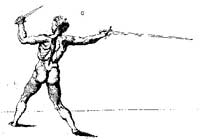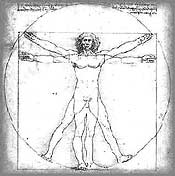The Agrippa Code: Metaphysics and the Center in Western Martial Arts
By Ken Mondschein
Students of Japanese martial arts are used to hearing about the hara,
the “center” of energy (ki) located from behind the navel.
Properly using the hara, we are told, is “ki” (pun intended)
to moving efficiently, generating power, and preventing injury. Many beginning
students dismiss the entire idea of hara and ki as quasi-mystical nonsense—at
least until they see for themselves that these concepts work in real life.
Additional proof of this concept can be seen by cross-cultural comparison.
The human body is a universal that doesn’t change with time or place.
Thus, we should not be surprised that Western arts have developed much
the same idea. For instance the Italian fencing theorist Camillo Agrippa,
in his 1553 “Treatise on the Science of Arms,” expressed a
very similar notion of the vita as the body’s physical, spiritual,
and energetic center. What’s more, Agrippa linked this idea to his
own culture’s ideas of metaphysics. The fact that similar ideas
appeared in disparate times and places not only points to the truth of
the concept of the hara/vita, but confirms that those who think that Western
fighting arts are devoid of spirituality are fooling themselves.
 |
Moving from the center as seen in an illustration
from Camillo Agrippa’s 1553 “Treatise on the Science
of Arms.” |
In modern Italian, vita means “waist.” It also quite tellingly
means “life.” However, language does not remain stable over
time. How would Agrippa’s contemporaries have understood him? One
clue comes from Renaissance dance manuals. In this period, dancing was
not just something done for amusement, but an intricate social ritual.
Knowing how to dance, like knowing how to use a sword, was one thing that
set a gentleman apart from a commoner. Fabritio Caroso, in his dance manuals
from 1581 and 1600, uses “vita” in both in the sense that
we mean “life”—both in terms of “civil life”
and the biological state of being alive—but also as the place from
where you should move. For Coroso, the vita something that can be ornamented
by dancing gracefully, or a part of the body that we have to move in certain
ways in order to properly perform certain actions in the dance. Caroso’s
contemporary Negri, in his 1604 book on dancing, likewise says that to
move gracefully, one has to carry the vita properly, and also that clumsy
people let their vita fall over one foot and then the other when they
walk, but that elegant people (which is to say gentlemen, which is to
say trained dancers and martial artists) ought to move from their vita
with moderate, balanced steps.
 |
Leonardo da Vinci’s 1492 illustration of
the "Vitruvian Man." |
We can thus see the multifarious meanings one word might have—the
vita is at once the source of bodily energy, our physical “center”—both
in terms of center of mass and middle of a man’s measure—and
life itself. We can see this Renaissance idea in Leonardo da Vinci’s
famous Vitruvian man, whose navel (that is to say, his vita) is both the
center point of the figure and of the circle representing the cosmos.
This figure is so-named because it represents the theories of the Roman
architect Virtuvius on how to construct a temple. In fact, the Vitruvian
plan was actually the original design for St. Peter’s Basilica in
Rome.
So how is this idea of the vita used combatively? Let’s look at
a technique from chapter 11 of the first book of Agrippa’s treatise:
. . .move your left foot up against the right and make an attack to
the right side of enemy’s body by pushing his sword aside with
yours. If he parries, disengage quickly, stepping with your right foot
towards his left side, and, voiding your vita, move your left foot to
hit him. . .
Agrippa is in other words instructing us to step away from the oncoming
thrust and twist our center of mass away from the enemy’s counterattack—not
too dissimilar from the idea of tai-subaki in karate.
 |
Illustration from Camillo Agrippa’s 1553
“Treatise on the Science of Arms.” |
Agrippa also gives us an example of a ball in Chapter 24 of the first
book. As he explains:
. . .If you were to place the ball on the ground and try to strike
it however you can, on whatever side you might wish to, you can well
imagine that you will not be able to strike it firmly, no matter whether
you hit it in the center or on the edge. This is because it defends
itself with its motion. In fact, if you study how it moves, you will
see that it is a naturally mobile instrument.
It therefore seems to me that this is a model of our bodies, which
are not like balls insomuch concerning what they are made of, but rather
in how they move. You can understand everything you need to know to
use the techniques I have discussed if you remember that our bodies
are the same as the ball and move with the same skill and agility. .
. .
While this can be seen as a simple example to express how one should
move in offense and defense, Agrippa’s ball would have reminded
the educated reader of the same Vitruvian classical circular conception
of the human body. In other words, human beings being (metaphorically)
spherical are naturally perfect, and capable of the most perfect form
of motion, rotation about a center.
What’s more, as Agrippa makes clear in the dialogue on astronomy
at the end of the book, we are microcosms of the cosmos. It thus ought
not to surprise anyone that we able to move in the same way that the heavenly
spheres do. (Agrippa published in 1553, ten years after Copernicus but
before everyone was convinced that the Earth goes around the sun.) This,
in turn, relates back to that same Vitruvian temple: The church in which
we pray to God, the Creator of the Universe, is a mirror of the cosmos
built to the proportions of man, who is created, in turn, in God’s
image.
As with other contemporary thinkers, Agrippa believes the human beings,
having been created in God’s image, to be naturally perfect. What
he is telling us, then, is that because of the nature of our own bodies
and our inherent worth as human beings, we ought to be able to perform
any action necessary for self-defense. Students of all martial arts would
do well to remind themselves of this. The vita is not only the key to
efficient movement, but also a moral and spiritual truth.
About The Author:
Ken Mondschein is a Ph.D student in history at Fordham University
and classically trained fencer currently enjoying his Fulbright grant
in Paris. A student of classical fencing and historical swordsmanship
under Maestro Ramon Martinez, he is also knowledgeable about European
classical dressage, the art of horsemanship, and its history and application
in mounted combat.
In karate he holds a black belt from Seido Karate in NYC. Ken is Associate
Editor for European Sword Arts for FightingArts.com and is a frequent
contributor to the web site.
|